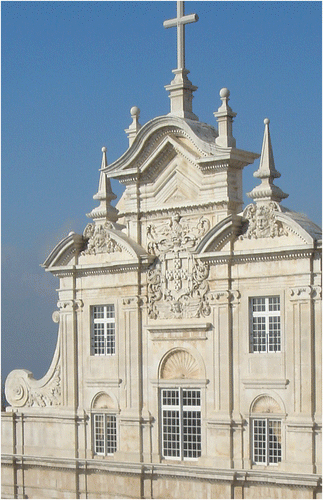An exhibition of mathematical art is held every year in association with the annual Bridges Conference exploring mathematical connections in art, music, and science. This year's conference and exhibition (http://gallery.bridgesmathart.org/exhibitions/2011-bridges-conference) took place in Portugal, July 27–31, at the University of Coimbra (founded in 1295). Participants from around the world gathered for an academic program of peer-reviewed papers and the juried art exhibition with mathematical content. The program was augmented by hands-on workshops, excursions to points of cultural interest and natural beauty, theatrical and musical events with mathematical themes, and a family day of programmes open to the public. While each of these offerings was ephemeral, the art exhibition catalogue [1] and the conference proceedings [4] are permanent publications designed to document current artistic and scientific research.
As an art historian, I was struck by the unique architectural and cultural context of Coimbra, a charming city and historical centre of learning, rich in artifacts and architecture that express interdisciplinary concerns analogous to those of Bridges participants. Situated in the upper town (‘Cidade alta’) atop a hill overlooking the Mondego River, the university landscape incorporates Renaissance monuments, a Baroque library, and physics and chemistry lecture halls of the nineteenth century. Just below the summit are the remains of the substructure of the Roman Forum with its network of intersecting barrel vaults (a tour of which was offered preceding the annual banquet) and a series of semi-circular arches on piers supporting a substantial aqueduct to bring water to the Roman city. At lower elevations are the Arab city gates with their typical arches that extend the arc of the circle beyond the horizontal diameter, and several magnificent Romanesque churches of the twelfth century, renovated and enlarged in the Gothic period (thirteenth century), again during the Renaissance and with additions of the eighteenth and nineteenth centuries. Unique to these churches are the early cultural influences of Portugal's vast overseas empire that resulted from the sixteenth century's Age of Exploration and Discovery – extending from Brazil in the Americas to Cape Verde off the coast of Africa, Goa on the Indian Ocean, and Macao on the China Sea.
Coimbra's cultural history embraced us, offering a frame through which to view the exhibition of contemporary mathematical art. Several of the works exhibited made explicit reference to the arts of past cultures: the white Carrara marble for the rough-hewn sculptures of Jacques Beck (), with its architectural allusion to the keystone of a vault, carved according to historic methods with point chisel and mallet, the English alabaster of the Mobius strip and Borromean rings carved and polished by Nicholas Durnan, and the use of various kinds of wood for the looped and interlaced carvings of Bjarne Jesperson. Traditions of historic manuscript illumination are acknowledged in the work of Conan Chadbourne (archival inkjet prints) and Anita Chowdry (digital print of painting on paper). And Paul Gailiunas draws inspiration from basket-weaving in his demonstrations of the chirality of hexagonal interlacing. Felt, a compacted fabric traditionally made from wool, is the medium selected for the zippered polygonal nets that form polyhedra in the collaborative works made by family members (Demaine, Demaine, Lubiw, Shallit & Shallit). An industrial felt of acrylic and wool is the basis for the laser-cut modular designs used by Eunsuk Hur to explore fashion possibilities for enclosing the human form. Other textile technologies were also evident in the art exhibition: traditional methods of quilting were used to explore contemporary mathematical subjects by Elaine Krajenke Ellison (six-point perspective and modularity/metamorphosis) and by Andreia Hall and Prudência Leite (fractals); and cutting, sewing, and draping informs the work of Jasmin Schaitl, which explores the fashion permutations of a single cloth edged by ribbon. In contrast to works made using traditional materials, tools, and techniques, other works relied upon twentieth- and twenty-first century digital technologies as a medium, such as in the computerized tracking methods used by Gary Greenfield to convey the complexity of physical or biological processes with a series of subjectively selected overlays in ambiguous colours (). Digital technologies also serve as means of documentation, recording, and reproduction, as in the use of digital photography by Marien Metz, Mike Naylor, Nick Sayers, Carlo Sequin, and Jasmin Schaitl. Digital technologies are paramount in the efforts to produce virtual sculptures, as for example in the work of Daniela Rinaudo and in the computer animations of Fergus Ray Murray. Three-dimensional printing in plastics and other materials to produce digitally generated and manufactured sculptures is evident in the work of Manuel Díaz Regueiro and Curtis Palmer; this technology seems especially effective for exploring topological phenomena in the works of computer scientist Carlo Sequin and mathematician Henry Segerman. Of historical note, there were explicit visual references to the Dutch graphic artist, M. C. Escher (Doug Dunham), Japanese print-maker, Hokusai (Mark Stock) and American artist, Sol LeWitt (Charlene Morrow). LeWitt is considered to be among the founders of the conceptual art movement [3], which has played such an important, although understated, role in the art-math world. In the titles of works there are numerous references to the explicitly mathematical worlds of Riemann (Francesco De Comite), Sierpinski (Andreia Hall and Prudência Leite; Jan W. Marcus; Mike Naylor), and Mandelbrot (Jan W. Marcus). The names of Pythagoras and Zeno are invoked in titles of works by Jan W. Marcus and James Mai, respectively, and Dante's Inferno is the title of a gouache painting by art educator Mary Wahr. Poetry figures in the works of Kazmier Maslanka, and with a literary allusion to Joyce Kilmer in the digital print of a tree by David Swart, “I Think That I Shall Never See…” and calligraphic quality of line plays a role in one of the digital giclée prints of Douglas McKenna. Several artists acknowledge the inspiration of recent Bridges participants: Jacques Beck's “multisculpture” references Nat Friedman's notion of “hyperseeing” [2]; Elaine Krajenke Ellison's quilt, Perspective of Paradise–Six-Point Perspective, cites Dick Termes’ systems of perspective, and Samuel Verbiese addressed a labyrinthine challenge put to him by Eva Knoll, which he captured using organic deformation and decay ().
Figure 1. Jacques Beck, La Clé de Voûte (Keystone), 2000, white Carrara marble, 355 × 170 × 110 mm. Reprinted with permission.
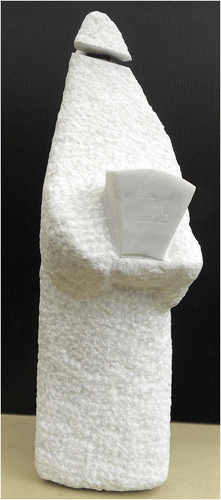
Figure 2. Gary Greenfield, Transport Network #2531, 2011, digital print, 6” × 4”. Reprinted with permission. See insert for colour version of this figure.
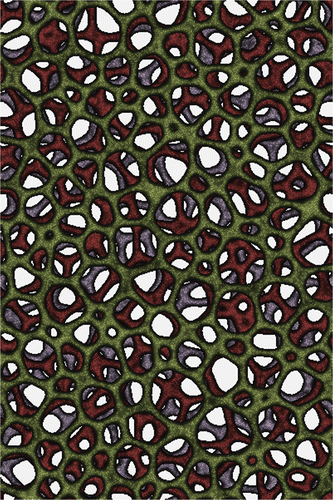
Figure 3. Samuel Verbiese, Labyrinthic EvaKnollization and St.Omerization of Grapefruit, 2011 (four views), grapefruit and permanent black ink, diameter 90 mm. Reprinted with permission. See insert for colour version of this figure.
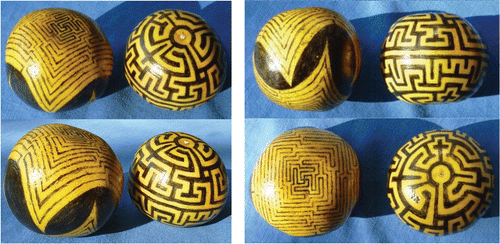
In considering the historical monuments of Coimbra as a framing device, one is struck by the similarities of certain mathematical themes (despite the lack of monumentality in the contemporary art exhibition) – the prevalence of polyhedra, the predominance of Euclidean space, and the repetition of design algorithms. Within the church of Santa Cruz, at the bottom of the hill, are extensive ceramic tile panels that carry a variety of Islamic influences in the formulation of rhythms and patterns of repetition, if not in the representation of monumental landscapes and narrative scenes executed in blue-and-white glazes. Just as lines and proportions inform the work of James Mai (), János Szász Saxon (), and Sean Stewart, strict proportions and a multiplicity of linear mouldings articulate the façade of the “New Cathedral” (), built originally as the College of the Jesuits at the top of the hill in a post-Renaissance neo-Classical style with broken pediments lending a distinctly Roman character to the work.
Figure 4. James Mai, For Zeno (Flowering), 2010, archival digital print, 14” × 14”. Reprinted with permission. See insert for colour version of this figure.
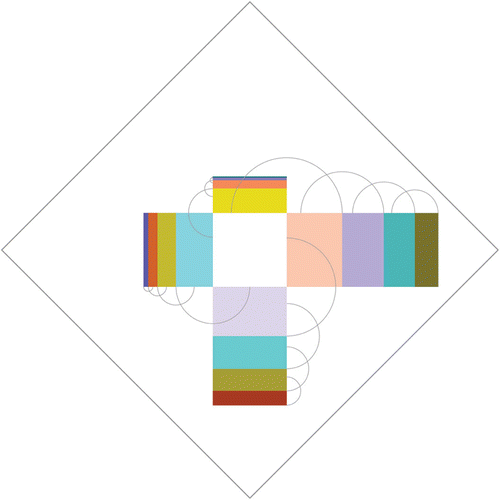
Figure 5. János Szász Saxon, The Seventh triptichon 2, 1991, oil on canvas, 100 × 100 cm. Reprinted with permission.
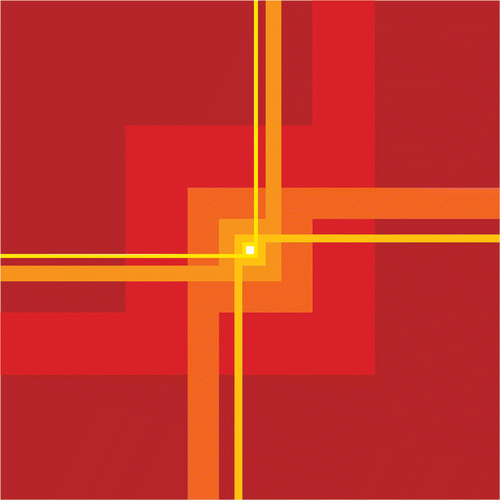
In contrast to the representational paintings, pictorial tapestries, and figural sculpture of Coimbra's cathedrals and churches, the artwork of Bridges is for the most part non-figural, although it is nonetheless representational, if not also expressive, of mathematical content with its focus on the abstractions of mathematical ideas and their representation in two- and three-dimensional space. But, at once, there are striking anomalies in the mathematical ideas of the late nineteenth and early twentieth centuries that challenged traditional norms, introducing relativity, non-Euclidean space, and, in the late twentieth century, quasi-crystalline tilings and the fractal dimension, all of which are amply represented in the art exhibition of Bridges Coimbra 2011.
Ably curated and facilitated by Robert Fathauer since 2001, and juried this year by Fathauer with Anne Burns, Ana Isabel Cardoso, and Nat Friedman, the on-site exhibition included mathematical artwork by more than sixty participants, with the work of more than seventy individuals represented in the catalogue [1]. Although a majority of contributors to the exhibition reside in the United States, the works on view represent a global cross-section of contemporary production of mathematical art with twenty other countries also represented. Fractals were yet again the most popular subject matter, expressed in works by Francesco De Comite, Robert Fathauer, Mehrdad Garousi, Teja Krasek, Jan W. Marcus, Mike Naylor, Andreia Hall and Prudência Leite, and Henry Segerman. Three-dimensional polyhedral sculptures in a variety of materials and forms also continued to be popular subjects: Krystyna Burczyk's elaborate constructions of coiled paper; Xavier De Clippeleir transformative wooden structures; the zippered felt polyhedral nets by Demaine, Demaine, Lubiw, Shallit & Shallit; Henry Segerman's space-filling graphs and fractals, made using selective laser-sintering; Richard Kallweit's painted wooden intersecting tetrahedra; Paul Gailiunas’ woven tetrahedra and hexagonal anti-prism; digital images of Mike Naylor's polyhedra built of human forms; and the platonic solids of Laura M. Shea's stringing of Swarovski crystals with monofilament. Tessellations and tilings of the plane appear in the works of Juan Escudero and Briony Thomas. Richard Kallweit explores polyhedral tilings, while Bente Simonsen, Spencer Smith, and David Swart explore tilings of the sphere. The space-filling curves of Samuel Verbiese on grapefruit exhibit symmetry-breaking due to natural deformations of dried out organic matter over time (). The representation of hyperbolic space is examined in the works of Doug Dunham, Robert Fathauer, and Elaine Krajenke Ellison. And negative curvature and minimal surfaces are expressed in the works of Aurora and Richard Kallweit. Magic squares generated works by Fang You and Hans Dehlinger, and number theory is present in the works of Margaret Kepner and Amy Selikoff. Radial symmetry this year provided the central focus of works by Anne Burns, Fabien Vienne, and Merrill Lessley. The natural world figures in the works of Françoise Beck-Pieterhons and Aurora, and is evoked in the abstractions created digitally by Nathan Selikoff. Modularity with metamorphosis is the subject of the work of Eunsuk Hur, Reza Sarhangi and Elaine Krajenke Ellison. Anamorphosis – distorted projection, which appears normal when viewed from a particular point and an appropriate mirror – informed works by two artists: Francesco De Comite used ray-tracing software to visualize a mathematical object, which he then realized in three dimensions and reflected on a sphere (), and Jan W. Marcus, who achieved the representation of fractals on cylindrical mirrors reflecting inkjet prints (). The use of anamorphosis with cylindrical mirrors was also a topic explored in nineteenth-century Coimbra, as exemplified by several exhibits in the Science Museum.
Figure 7. Francesco De Comite, 3D anamorphosis, 2011, wood and plastic, 40 × 40 × 20 cm. Reprinted with permission.
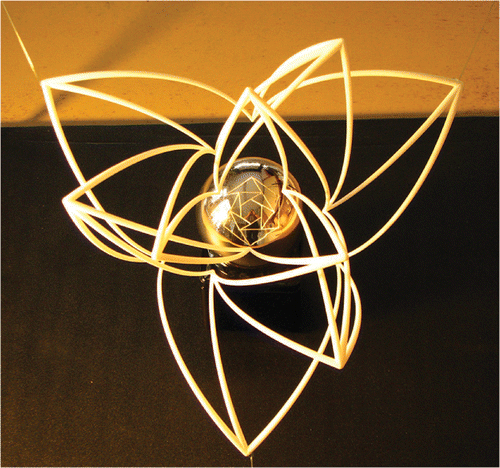
Figure 8. Jan W. Marcus, Mandelbrot, 2011, inkjet print / reflecting cylinder, 210 × 297 × 200 mm. Reprinted with permission.
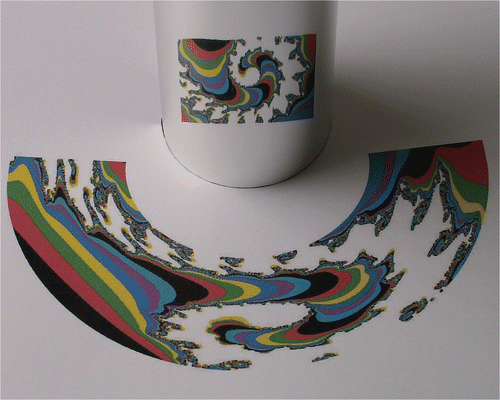
From an aesthetic point of view, I was particularly captivated by the tangram dissections of Horst Schaefer (). Good craftsmanship was evident in the crisp edges of triangles and the subtle curvature of paper impressed by copper plates; his effective use of intaglio printing techniques with black ink resulted in an intriguing minimalism designed to portray the application of rules and forms. I found the multi-faceted design documentation of a weaving by Marien Metz aesthetically pleasing (Portuguese Colors 2, ), based on the colours of Portugal's flag, but I missed seeing the actual textile, which was represented only by the close-up digital image of a detail. The designs show both an algebraic and an algorithmic approach to weaving double cloth, in which two colours alternate front and back, as illustrated (). I was fascinated by the group theory approach to Solar Orbits () by Charlene Morrow, a work in origami that reproduces the sophisticated colour arrangements of Sol LeWitt's Wall Drawing #413, which is on view at the Massachusetts Museum of Contemporary Art in North Adams until 2034. The words, lines, colours, and overlapping shapes of Gaussian Music (), an archival print by Anna Ursyn, reminded me of the Cubist paintings of Georges Braque, which reflected new interest in geometry and simultaneous perspectives in the early twentieth century.
Figure 9. Horst Schaefer, Rule and Form – Rule 50 – Chain, corners with an angle of 45 degree are touching corners with a right angle, 2010, intaglio printing on paper, 20” × 24”. Reprinted with permission.
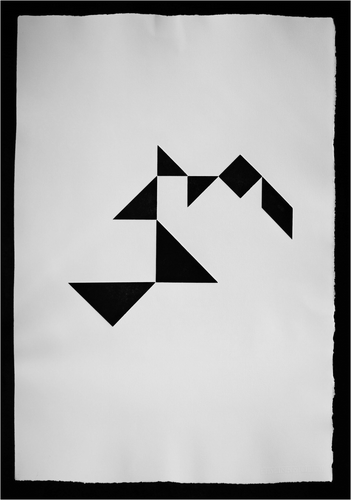
Figure 10. Marien Metz, Portuguese Colors 2, 2011, design for hand-woven textile, 400 × 300 mm. Reprinted with permission.
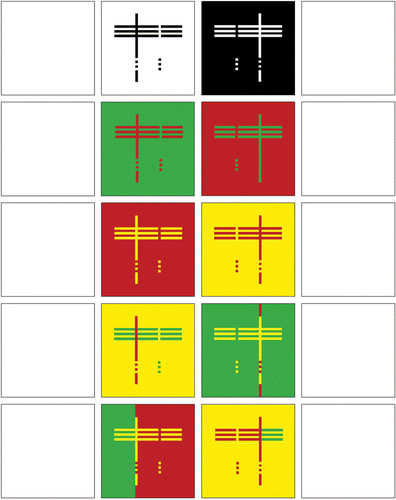
Figure 11. Charlene Morrow, Solar Orbits, 2011, folded paper, 12” × 30”. Laura Weston, Mount Holyoke College. Reprinted with permission. See insert for colour version of this figure.
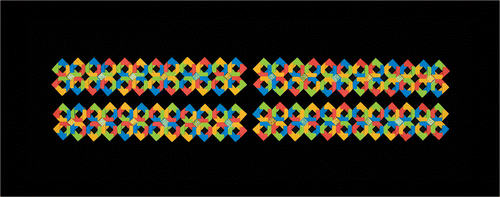
Figure 12. Anna Ursyn, Gaussian Music, 2010, archival print, 10” × 8”. Reprinted with permission. See insert for colour version of this figure.
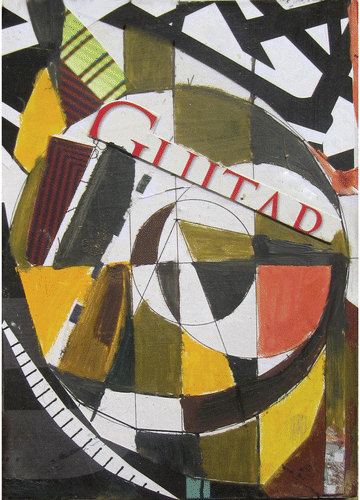
Amidst the beauty of Coimbra's white limestone monuments and decorative black-and-white cobbled pavements, the exhibition was installed in a mid-century modern building, its hard-edged glass, steel, and concrete set within a multi-level recessed cement courtyard. The exhibition took place underground, illuminated with overhead fluorescent lighting in a gallery adjacent to the Main Lecture Hall. Wood panelling lent a touch of warmth to an otherwise unappealing interior space; although convenient and therefore accessible for viewing, many of the works would have benefited from a larger gallery with natural light or a more formal installation with additional focused gallery display lighting, but the ephemeral nature of the event precluded such facilities. Despite the insurmountable constraints that surround such temporary exhibitions, including size limits to meet requirements for travel and shipping, the art exhibition at Bridges Coimbra 2011 excelled in its variety and quality, attesting to the vibrant and intense artistic exploration of mathematical subjects globally by both artists and mathematicians.
References
- Fathauer , R and Selikoff , N . (eds.), Bridges Coimbra: Mathematics, Music, Art, Architecture, Culture – Art Exhibition Catalogue 2011, Tessellations Publishing, Phoenix, Arizona, 2011
- Friedman , N . Hypersculptures. In E. Akleman and N. Friedman (eds.), Sixth Interdisciplinary Conference of the International Society of Arts, Mathematics, and Architecture, Texas A&M University, College Station, Texas, 2007, pp. 39-48. Available online at: http://www.isama.org/hyperseeing/ (accessed 5 September 2011)
- LeWitt , S . Paragraphs on Conceptual Art, Artforum, June 1967
- Sarhangi , R and Sequin , C . (eds.), Bridges Coimbra 2011: Mathematics, Music, Art, Architecture, Culture Conference Proceedings, Tessellations Publishing, Phoenix, Arizona, 2011
